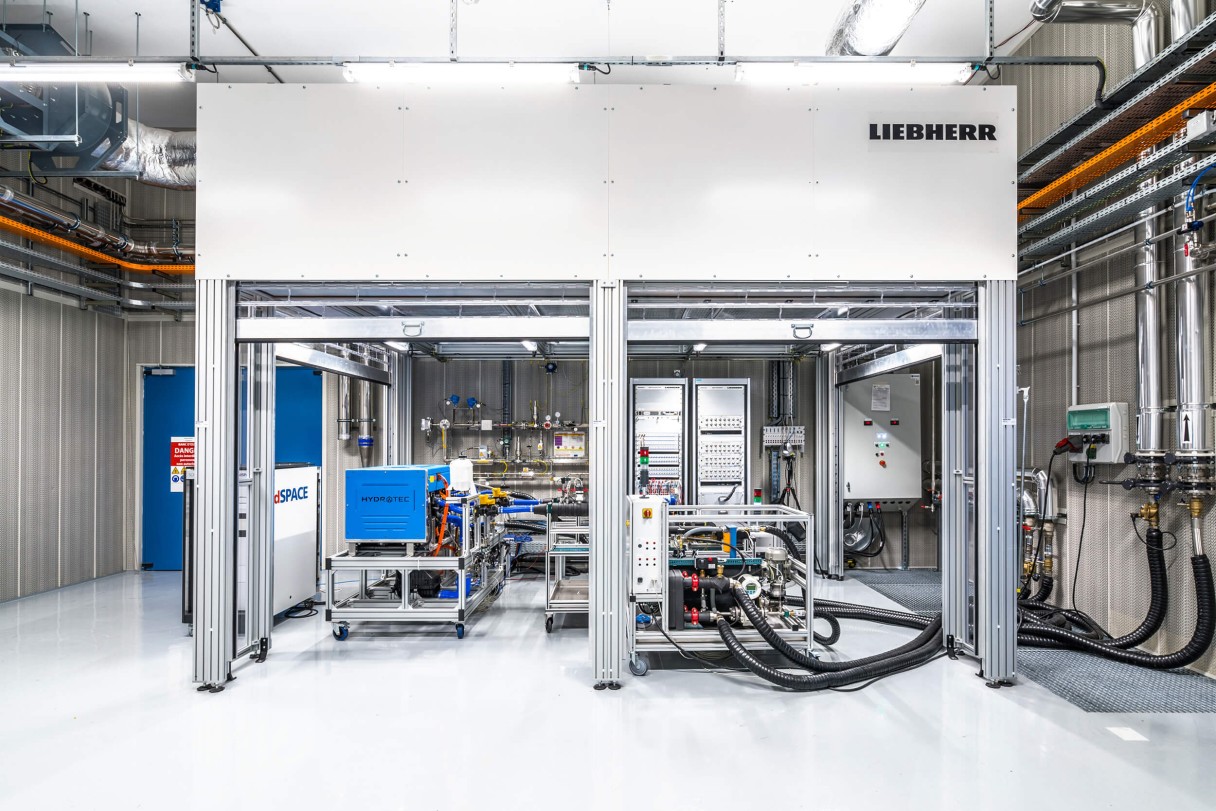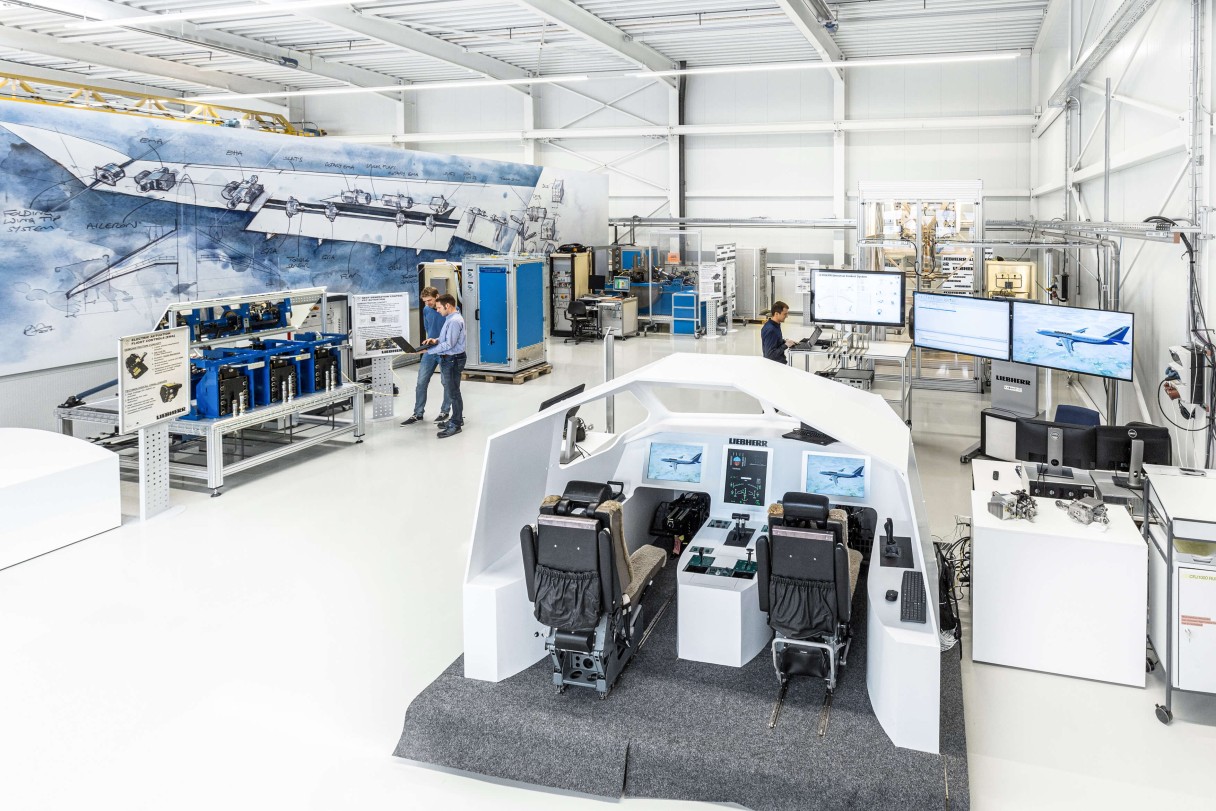Decarbonization is key
Aviation connects: Millions of people travel across the globe every day. However, the industry faces several significant challenges like environmental impact and technological advancements. Yann Juaneda, Director Engineering R&T at Liebherr-Aerospace Toulouse SAS (France) and Sebastian Ziehm, Head of Program Management Technology Development at Liebherr-Aerospace Lindenberg GmbH (Germany), provide insights into how Liebherr is shaping the future of aviation, meeting the challenges of decarbonization, and what solutions the company is already offering.

Hydrogen test bench at Liebherr-Aerospaceʼs test center in Toulouse (France)
Decarbonizing aviation is rather complex and requires tight collaboration across the entire aviation ecosystem.
What are the challenges for the decarbonization of aviation in general?
Yann: The challenges are multifaceted and range from the still limited availability and high costs of Sustainable Aviation Fuel to regulatory and policy frameworks to support the transition and the development and deployment of new technologies.
Decarbonizing aviation is rather complex and requires tight collaboration across the entire aviation ecosystem. This includes aircraft manufacturers, their supply chain, airlines, airports and finally the passengers. What we con¬tribute as one of the system suppliers to this ecosystem is innovative, reliable and more sustainable technology for todayʼs and next generation of aircraft. Fly Net Zero is the commitment of the entire aircraft industry to achieve net zero carbon by 2050 and the goals that we have set ourselves are very challenging.
Sebastian: The European Green Deal Framework and the Strategic Research and Innovation Agenda, which was initially released by ACARE in 2012 and updated by Clean Aviation in 2024, are setting the scene for the key objectives: Climate-neutral aviation by 2050, supported by 30 % greenhouse gas reduction by 2030 vs. 2020 aircraft, 90 % CO₂ net reduction when combined with Sustainable Aviation Fuel or hydrogen and zero CO₂ emissions in-flight for hydrogen-powered aircraft.
As Yann mentioned, transitioning to climate neutrality is not just about new aircraft — it requires re-inventing inno¬vation, infrastructure, fuel supply chains, and certification frameworks, all under tight economic and environmental constraints. It is disruptive for the whole aviation ecosystem. Aviation contributes approximately 2.5 % of global CO₂ emissions, and demand for air mobility is projected to double by 2050. This makes it one of the most difficult sectors to decarbonize due to long development cycles and stringent safety standards.
How is Liebherr tackling these challenges?
Sebastian: We consistently invest more than the industry-average in research and development activities in our fields of expertise, like landing gears, environmental control and thermal management systems as well as flight control, actuation and hydraulic systems. Our R&T projects are all about coming up with innovative technologies for new or improved products. These innovations will help our customers develop aircraft with less greenhouse gas emissions while remaining competitive.
Yann: We are involved in French, German and Europe-wide research projects to find solutions together with industry and academic partners. We are for example one of the many members of Clean Aviation Joint Undertaking (CAJU), the European Unionʼs leading research and innovation program. The goal of CAJU is to develop an aircraft with a low carbon footprint during development, production and operation. In flight, it can be achieved with the effect of Sustainable Aviation Fuels or targeting zero CO2 emissions when using hydrogen as an energy source.
We also work closely together with industrial partners under the Conseil pour la Recherche Aéronautique Civile. This is a French research and development program that focuses on decarbonization and safe aviation.
In Germany, the Luftfahrtforschungsprogramm, the German Aeronautical Research Program, is the main source of financial funds for our R&D activities.
In addition to our core products and technologies, we are of course also continuously improving our own facilities, production sites and processes. This includes, for example, model-based engineering, the manufacturing process and recyclability during the product life cycle, i.e. what we can reuse.
Liebherr plays a vital role in creating more efficient and more sustainable next-generation aircraft.
Which products is Liebherr-Aerospace focusing on?
Sebastian: Our present research focuses on several key areas including the development of next generation electric actuators, electric environmental control systems, auxiliary power generation systems, electrical-driven hydraulic power supply, and thermal and energy management for increasingly electrically-powered aircraft. The adoption of a more electric aircraft concept is a key strategy to enhance energy efficiency, thereby reducing fuel consump¬tion and lowering CO2 emissions.
Some examples: The concept of our new small electro-mechanical actuatorsʼ family allows the transition from customized design to customized assembly of standardized modules. Our design approach offers scalability for small installation envelopes, beneficial power-to-weight ratio and high reliability.
The remote control unit is a perfect match with these electromechanical actuators. It enables system and position control, data concentration, monitoring, and signal conversion.
Together with our small electromechanical actuator family concept, both the remote electronic unit, and the small electromechanical actuator are technology enablers for new functions needed with respect to future high aspect ratio, very thin wings. These functions can protect the wing structure against structural loads induced by gusts and flutter phenomena. Therefore, if the high aspect ratio wing is the aircraft manufacturersʼ choice to lower air¬craft CO2 emissions, and the indications for that are quite clear today, then we are well positioned with our Liebherr technology portfolio under development.
Yann: One of our projects consists of a more energy efficient electrical environmental control system. Instead of bleeding the air from the engines, the electrical envi¬ronmental control system will use only air from outside the aircraft. This means that the engines will have more thrust available and that the system will include highly efficient electrically driven turbomachines.
Less bleed architectures are also making very promising progress from integration, reliability and efficiency standpoints if pneumatic energy remains the best aircraft compromise.
Sebastian: Last but not least, we are working intensively on advanced materials and manufacturing techniques, like additive manufacturing, to achieve significant weight reductions in our products while maintaining or improving their performance. It also enables new design freedom for complex geometries, contributes to material waste reduc¬tion, allows customization and is an enabler for reducing lead time e.g. for early prototypes in development.
In a nutshell, one can say that we are at the forefront of innovation, and that Liebherr plays a vital role in creating more efficient and more sustainable next-generation aircraft.


